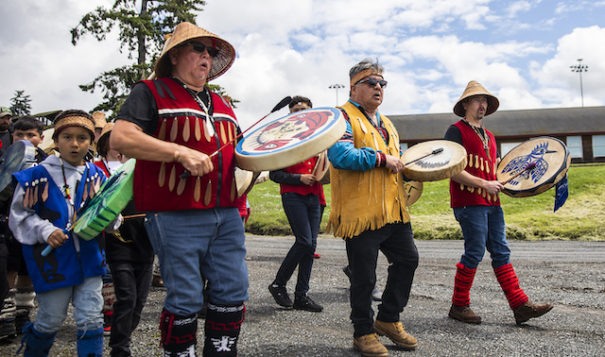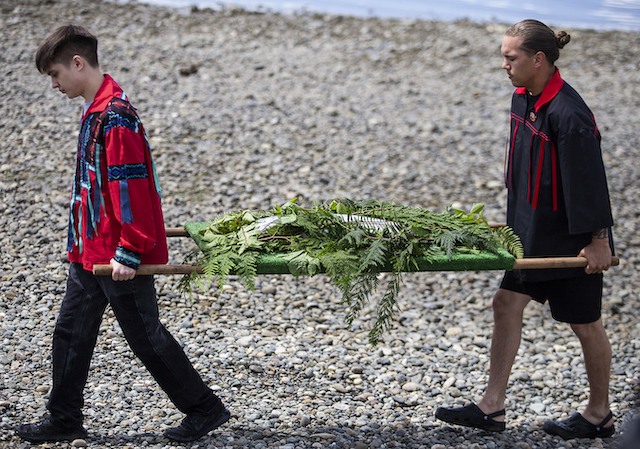News Article Article pages that do not meet specifications for other Trust Project Type of Work labels and also do not fit within the general news category.
‘Back in our home’: Tulalips celebrate Salmon Ceremony return
 Tulalip drummers and singers make their way down to the water to greet the king salmon as it is carried back to the longhouse during Salmon Ceremony on Saturday, June 11, 2022 in Tulalip, Washington. (Olivia Vanni / The Herald)
Tulalip drummers and singers make their way down to the water to greet the king salmon as it is carried back to the longhouse during Salmon Ceremony on Saturday, June 11, 2022 in Tulalip, Washington. (Olivia Vanni / The Herald)
TULALIP RESERVATION, Wash. — Three generations gathered around a single crackling fire, warming the faces of their drums near the flames.
Slowly, drummers’ beats rose to a crescendo, soon joined by cedar rattles and bellowing voices. Harriette Shelton Dover’s “Welcome Song” carried along the cedar walls of the longhouse Thursday night. It was the final practice before the Tulalip community’s annual Salmon Ceremony.
“When we lived in these homes we practiced our culture daily, it was shared daily and taught to our young ones,” former Tulalip Tribes vice chair Glen Gobin said to a packed longhouse. “We live in a different world today … but the teachings need to still come forward, so we start to prepare for Salmon Ceremony by practicing because we’re not living in this home any longer.”
On Saturday, over 100 people gathered on Tulalip Bay to welcome a visitor: yubəč, or the King Salmon. It was a joyous return of the annual tradition.
The wooden longhouse seats, packed with guests from as far away as the Makah tribe, trembled as drummers and singers moved the smoke-filled air for hours. Each song, each story, each blessing was passed down orally, Gobin said.
The late longtime tribal chairman Stan Jones Sr. gave his song “Eagle/Owl” to the ceremony. It came to him while traveling through Deception Pass — a spiritual place for many Coast Salish people, Gobin said. As the song echoed through the longhouse, dancers draped in shawls spread their arms wide and spun, as if to glide through the room.
Elder Bev Tom passed down the song for the blessing of the fishermen, Gobin said. She died just a year after sharing her song. Tribal citizens sang it again and again as fishers and canoe-pullers were blessed one by one Saturday morning.
As a canoe headed toward the shore of Tulalip Bay with the first King Salmon, drummers and singers carried a prayer song down to the beach. People in woven cedar hats, clothing adorned with abalone shells and small cedar paddles, ribbon shirts and skirts soon spilled into the gym to share the first piece of salmon together.
Drew Hatch, who helped carry the salmon ashore, sat with his grandmother, Lena Hammons, for the meal. Hammons recalled Hatch coming to salmon ceremonies every year since he was a toddler.
It’s even more significant to him now as a fisherman, Hatch said.
Each year, the return of the monarch butterfly and ripening salmon berries “means it’s time to get ready” for the return of the King Salmon, Glen Gobin said.
Salmon Ceremony is a responsibility, said Patti Gobin, who has been a part of the annual tradition since its return in the late 1970s.
Oral tradition says if people cease to honor the King Salmon, he will cease to return every season and the salmon people will cease to exist, Patti Gobin said. After the meal, his remains were returned to the water so he could tell his people how the Tulalip Tribes treated him.
In 1970, Harriette Shelton Dover gathered tribal leaders — Morris and Bertha Dan, Stan and Joann Jones, Gloria St. Germaine, Molly Hatch, Mariah Moses, Fillmore Amos and Bob and Celia Jones — at Bernie Gobin’s house to begin planning the revival of their ancestors’ Salmon Ceremony.
The ceremony was paused for decades during the assimilation era, but elders held onto that knowledge, Chelsea Craig said. She’s been coming to Salmon Ceremony with her mom, Patti Gobin, since she was a baby.
“To me, it’s not revitalization,” Craig said. “It’s the sustainability of our people. In spite of the boarding school, we have always maintained who we were as Coast Salish people.”
In her autobiography, Shelton Dover recalls piecing together what she and others heard from their parents and grandparents of the annual tradition.
“I wrote what I thought and we made a good outline: the introduction or the first opening song, the blessing of the longhouse,” she wrote. “Then we met again to beat the drums … we sang what we remembered.”
The ceremony was revived in 1976.
Natosha Gobin has been going to Salmon Ceremony for as long as she can remember. Iconic Tulalip leaders like her grandpa, Bernie Gobin, and Stan Jones taught her the way.
In 2020, the pandemic forced tribal leaders to announce the cancellation of the salmon ceremony for the first time since its revival. In 2021, it returned as a smaller gathering.

Children dressed as warriors for the Salmon Ceremony play outside the longhouse before heading inside on Saturday in Tulalip. (Olivia Vanni / The Herald)
Children dressed as warriors for the Salmon Ceremony play outside the longhouse before heading inside on Saturday in Tulalip. (Olivia Vanni / The Herald)
“One of the things that we talk about is how that affects our spirit,” Natosha Gobin said. “It was a struggle to not have community and to not have each other and to not be able to share a meal with one another — a meal of salmon. Something as simple as just being in each other’s presence.”
The pause in annual gatherings seems to have drawn people back to their heritage, Lushootseed language instructor Thomas Williams said. Some people who showed up for practices this year have never attended Salmon Ceremony.
“I think it’s given people the dire need and want to utilize the things that maybe they didn’t think were as important before,” he said. “… They’re wanting to learn the songs, and they’re trying to understand the community that they’re in.”
Harriette Shelton Dover was the first generation of the revival, Glen Gobin said. Stan Jones was the second generation of the revival. His generation, Chair Teri Gobin’s generation, are the third generation. His sons and daughters, he said, are the fourth generation. His grandkids are the fifth generation.
“That’s in one lifetime,” Glen Gobin said, “that we can witness passing on the teachings.”
Today it’s still a form of medicine, said Tayna Greene.
Williams, a fisherman, didn’t start participating in salmon ceremony until he met his partner, Natosha Gobin. Now it’s an integral part of his life.
“It puts it all into context,” he said, “to come to ceremony and kind of step out of the modern style of fishing, but get more into like thinking along with what our ancestors thought about the salmon.”
Image Enick, 15, said he would never have made it to his first Salmon Ceremony without the encouragement of Craig, his teacher at the time. She took Enick and his friend to practices and “taught us the importance of just singing loud and singing proud.”
He was nervous at that first ceremony, but not anymore.
“I’m excited to be back in our home again — where our ancestors had that ceremony, in the same place — and honor our King Salmon,” Enick said. “Let him know that we’re in civilized times but these teachings are still here. And we got it under control.”
Dateline:
TULALIP RESERVATION, Wash.
